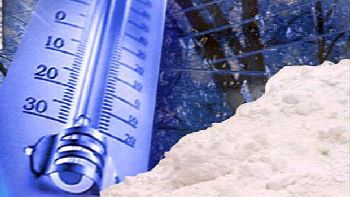 01/03/14 The National Weather Service extended forecast is indicating that very cold air will overspread the area beginning Sunday night and continuing into early next week. The temperatures will be bitterly cold with highs on Monday and Tuesday expected to be below zero at -1 and -3. Low temperatures and wind chills are likely to be in the double digits below zero.
01/03/14 The National Weather Service extended forecast is indicating that very cold air will overspread the area beginning Sunday night and continuing into early next week. The temperatures will be bitterly cold with highs on Monday and Tuesday expected to be below zero at -1 and -3. Low temperatures and wind chills are likely to be in the double digits below zero.
Extremely cold temperatures, such as those that are forecast, are dangerous to people, animals, and property. If you must be outside during extremely cold temperatures, dress appropriately for the weather conditions. Cover as much skin as possible to prevent injuries and take frequent breaks indoors to stay warm. Do not ignore shivering. It’s an important first sign that the body is losing heat. Know the signs and symptoms of hypothermia and frostbite.
Warnings signs of hypothermia: • bright red, cold skin • shivering, exhaustion • confusion, fumbling hands • memory loss, slurred speech • drowsiness If you notice any of these signs, take the person’s temperature. If it is below 95 degrees, seek medical attention immediately. If no medical care is available, or not immediately available, begin warming the person: • Get the victim into a warm room or shelter. • Remove any wet clothing. • Warm the center of the body first. Electric blankets or your own body heat can help. • Warm beverages can help increase the body temperature, but not alcoholic beverages. • Keep the person dry and wrapped in a warm blanket, including the head and neck.
The danger of frostbite: Frostbite is an injury to the body that is caused by freezing. Frostbite causes a loss of feeling and color in affected areas. It most often affects the nose, ears, cheeks, chin, fingers, or toes. Frostbite can permanently damage the body, and severe cases can lead to amputation. The risk of frostbite is increased in people with reduced blood circulation and among people who are not dressed properly for extremely cold temperatures. At the first signs of redness or pain in any skin area, get out of the cold or protect any exposed skin. You should also know the symptoms: • a white or grayish-yellow skin area • skin that feels unusually firm or waxy • numbness You should seek medical attention if conditions to the affected area do not improve.
Preventing Frozen Pipes: Pipes in attics, crawl spaces and outside walls are all vulnerable to freezing, especially if there are cracks or openings that allow cold, outside air to flow across the pipes. Cracks and holes in outside walls and foundations near water pipes should be sealed with caulking to keep cold wind away from the pipes. Vulnerable pipes that are accessible should be fitted with insulation sleeves or wrapping (which slows the heat transfer), the more insulation the better. Kitchen and bathroom cabinets can keep warm inside air from reaching pipes under sinks and in adjacent outside walls. It’s a good idea to keep cabinet doors open during cold spells to let the warm air circulate around the pipes. Electric heating tapes and cables are available to run along pipes to keep the water from freezing. These must be used with extreme caution; follow the manufacturer’s instructions carefully to avoid the risk of fire, and check to make sure the product conforms to UL 2049. Tapes and cables with a built-in thermostat will turn heat on when needed. Tapes without a thermostat have to be plugged in each time heat is needed, and may be forgotten. A dripping faucet wastes some water, so only pipes vulnerable to freezing (ones that run through an unheated or unprotected space) should be left with the water flowing. The drip can be very slight. Even the slowest drip at normal pressure will provide pressure relief when needed. Where both hot and cold lines serve a spigot, make sure each one contributes to the drip, since both are subjected to freezing. If the dripping stops, leave the faucet(s) open, since a pipe may have frozen and will still need pressure relief. If you would like additional information regarding safety tips during extremely cold temperatures, contact the Marshall County Emergency Management Agency at 574-936-3740.














